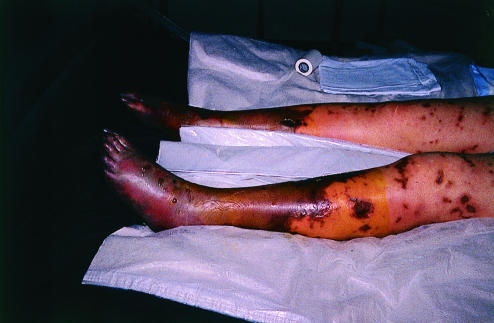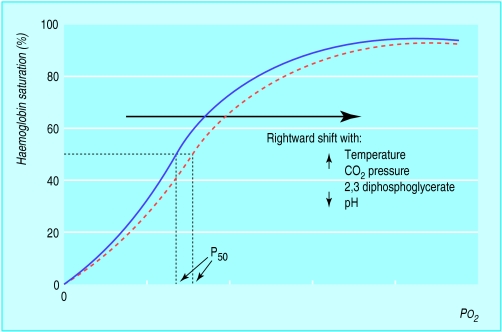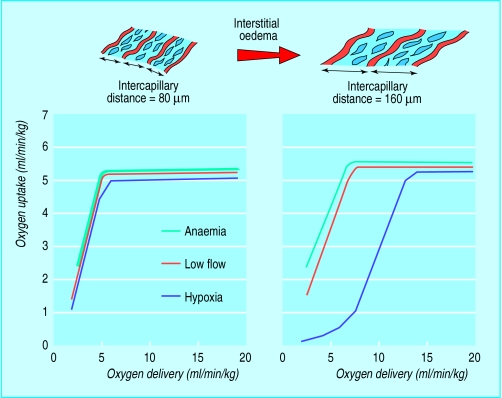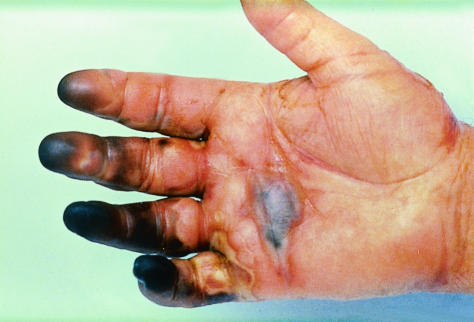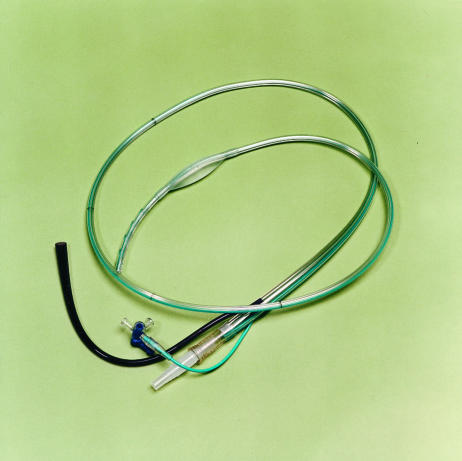Tissues vary considerably in their sensitivity to hypoxia. Neurological cells tolerate hypoxia for only a few minutes whereas bladder smooth muscle may survive for several days without oxygen. This has important implications in the management of oxygen transport and monitoring of tissue hypoxia in critically ill patients.
Regional oxygen transport and cellular use are often neglected but are important in maintaining tissue function and overall survival
Oxygen transport
Delivery to organs and tissues
The mechanisms controlling oxygen distribution are incompletely understood but involve a series of convective and diffusive processes. Convective oxygen transport refers to the bulk movement of oxygen in air or blood and depends on active, energy consuming processes generating flow in the tracheobronchial tree and circulation. Diffusive transport refers to the passive movement of oxygen down its concentration gradient across tissue barriers, including the alveolar-capillary membrane, and across the extracellular matrix between the tissue capillaries and individual cells to mitochondria. The amount of diffusive oxygen movement depends on the oxygen tension gradient and the diffusion distance.
In many critically ill patients tissue hypoxia is due to disordered regional distribution of blood flow both between and within organs. Regional and microcirculatory distribution of cardiac output is determined by a complex interaction of endothelial, receptor, neural, metabolic, and pharmacological factors working on small resistance arterioles and precapillary sphincters. In critical illness, particularly sepsis, hypotension and loss of normal autoregulation cause shunting and tissue hypoxia in some organs despite high global oxygen delivery and mixed venous saturation. The perfusion pressure is an important determinant of regional perfusion, but adrenaline or noradrenaline given to maintain systemic blood pressure may reduce regional distribution, particularly to the renal and splanchnic capillary beds.
Drugs are often used to try to improve regional tissue perfusion. Dopamine has been widely used in the belief that it improves renal blood flow, but it probably increases overall cardiac output rather than regional distribution. Dopexamine, which has no alpha effects, may selectively increase renal and splanchnic perfusion.
Factors affecting extraction ratio of oxygen from capillary blood
Rate of oxygen delivery to the capillary
Oxygen-haemoglobin dissociation relation
Size of the capillary to cellular Po2 gradient
Diffusion distance from the capillary to the cell
Rate of use of oxygen by cells
During critical illness tissue hypoxia is often caused by capillary microthrombosis after endothelial damage and neutrophil activation rather than by arterial hypoxaemia. Manipulation of the coagulation system using low molecular weight heparins may reduce microthrombosis. Thrombosis or embolism in a large artery can also produce organ or tissue hypoxia despite adequate global oxygen delivery. Surgical or pharmacological removal of the obstruction is needed before irreversible damage occurs. Ideally, individual tissue oxygenation needs to be measured directly to assess and manage organ hypoxia correctly.
Capillary blood to individual cells
In healthy resting adults the overall extraction ratio of oxygen from capillary blood is about 25% but may increase to 70-80% during maximal exercise in well trained athletes. Although the oxygen content of blood is linearly related to saturation, the relation between partial pressure of oxygen (Pao2) and saturation is non-linear. Various physicochemical factors affect the position of this sigmoid relation, which is defined by the oxygen concentration at which 50% of the haemoglobin is saturated (P50)—normally 3.5 kPa. A shift in the capillary oxygen-haemoglobin dissociation curve to the right enhances release of oxygen to tissues and improves oxygen availability. Provided that Pao2 does not fall much below 8 kPa the loss of oxygen uptake in the lungs is small but the increased release in the tissues is significant and the net effect is beneficial, increasing venous and tissue oxygen concentrations.
Although most doctors know the effects of temperature and acidosis, the importance of correcting hypophosphataemia is often overlooked. The concentration of inorganic phosphates in red cells, notably 2,3-diphosphoglycerate, affects the structure of the haemoglobin molecule and its affinity for oxygen. Reduced concentrations (as found in old blood from blood banks) reduce the P50. Similarly, hypophosphataemia in diabetic ketoacidosis and sepsis may result in tissue hypoxia because the release of oxygen from capillary haemoglobin is impaired.
Diffusion depends on the oxygen tension gradient and the diffusion distance, which is related to the tissue capillary density. The greater the difference between capillary and cellular oxygen concentrations and the shorter the distance, the faster the rate of diffusion will be.
Mathematical models of tissue hypoxia show that the fall in cellular oxygen resulting from an increase in intercapillary distance is more severe if delivery of oxygen to tissues is reduced because of “hypoxic” hypoxia (a fall in Pao2) rather than “stagnant” (a fall in flow) or “anaemic” (reduced haemoglobin) hypoxia. Thus, tissue oedema due to increased vascular permeability or excessive fluid loading may cause impaired oxygen diffusion and cellular hypoxia, particularly in conditions associated with arterial hypoxaemia. In such cases careful fluid balance may prevent tissue hypoxia.
Cellular use of oxygen
The cellular metabolic rate determines the overall oxygen consumption. Cellular use of oxygen is inhibited by many metabolic poisons, the best known of which is cyanide. Cellular toxins associated with sepsis (such as endotoxins) and other critical illnesses may also inhibit cellular metabolism and decrease oxygen use. The relative effects of tissue hypoxia due to inhibition of cellular use or excessive oxygen consumption are not established.
Factors affecting metabolic rate
Increased rate
Temperature—oxygen demand increases 10-15% for every 1°C rise
Sepsis or systemic inflammatory response syndrome
Burns, trauma, surgery
Sympathetic activation: pain, agitation, shivering
Interventions: nursing procedures, physiotherapy, visitors
β agonists, amphetamines, and tricyclic antidepressants
Feeding regimens containing excessive glucose
Decreased rate
Sedatives, analgesics, and muscle relaxants
Oxygen concentration for half maximum activity (Kmo2) of cellular enzymes
| Enzyme | Substrate | Kmo2 (kPa) |
|---|---|---|
| Glucose oxidase | Glucose | 7.6 |
| Xanthine oxidase | Hypoxanthine | 6.7 |
| Tryptophan oxygenase | Tryptophan | 4.9 |
| Monoamine oxidase | Catecholamines | 4 |
| Nitric oxide synthase | l-Arginine | 4 |
| NADPH oxidase | Oxygen | 3 |
| Cytochrome aa3 | Oxygen | 0.007 |
When is a tissue hypoxic?
The mechanisms that allow tolerance to hypoxia and prevent tissue damage are poorly understood. The mitochondrial partial pressure of oxygen required to generate the high energy phosphate bonds (ATP) that maintain aerobic cellular biochemical functions is only 0.13-0.4 kPa. However, hypoxia can cause failure of energy dependent membrane ion channels with subsequent loss of membrane integrity, changes in cellular calcium homoeostasis, and changes in cellular enzyme activity. An enzyme’s sensitivity to hypoxia is a function of the oxygen concentration at which it has half maximum activity (Kmo2).
Cellular tolerance to hypoxia may involve “hibernation” strategies which reduce metabolic rate, increased extraction of oxygen from surrounding tissues, and adaptations of enzymes to allow metabolism at low partial pressures of oxygen. Anaerobic energy production is important to the survival of some tissues despite its inefficiency. Skeletal muscle increases glucose uptake by 600% during hypoxia and bladder smooth muscle can generate up to 60% of total energy requirement by anaerobic glycolysis. In cardiac cells anaerobic glucose use protects the integrity of cell membranes by maintaining energy dependent potassium channels.
Tolerance to hypoxia of various tissues
| Tissue | Survival time |
|---|---|
| Brain | <3 min |
| Kidney and liver | 15-20 min |
| Skeletal muscle | 60-90 min |
| Vascular smooth muscle | 24-72 h |
| Hair and nails | Several days |
Maintenance of blood flow to the most hypoxia sensitive organs should be a primary therapeutic goal. Recognition of hypoxia in less oxygen sensitive tissues is also important but can be difficult. A patient with splanchnic ischaemia secondary to a mesenteric embolus will present with abdominal pain, distention, and a metabolic acidosis, which may be confused with other intra-abdominal conditions. Tissue death may not occur as rapidly as in highly hypoxia sensitive tissues but delayed diagnosis will have equally serious consequences.
Tolerance to hypoxia differs in health and disease. Acclimatised healthy highlanders living in mining towns at high altitude (4000 m) with a resting Pao2 of 6.5-8 kPa have a relatively normal life expectancy and suffer few medical problems despite the heavy manual work. In contrast, patients with chronic lung disease and persistent hypoxaemia (Pao2<8 kPa) have a 50% three year mortality; this is significantly improved with long term oxygen therapy.
Extreme degrees of tolerance to tissue hypoxia are seen in many animals. The bar headed goose migrates 2400 km at an altitude of over 9500 m from Southern India to its breeding sites in Tibet. Under experimental conditions it can ascend to 12 000 m, during which the Pao2 falls to 2.5-3.5 kPa. The metabolic rate remains high, and the only adaptation in the flight muscles to deal with this tissue hypoxia seems to be an increase in the capillary density with reduced diffusion distance.
What level of oxygenation will prevent tissue damage?
The level of tissue oxygenation required to prevent cellular damage depends on the circumstances and the expected duration of hypoxia. In a patient with acute respiratory distress syndrome in intensive care prolonged hypoxaemia with saturations as low as 85% may be accepted in an attempt to prevent ventilator induced lung injury. Oxygen delivery would be optimised by maintaining cardiac output and haemoglobin concentration and ensuring oxygen is released to tissues by manipulating the oxygen-haemoglobin dissociation curve. In contrast, prognosis in chronic obstructive pulmonary disease is improved by continuous oxygen to maintain the Pao2 above 8 kPa and the saturation over 90%. Similarly, the extent of atheroma affects tolerance to hypoxaemia.
Factors needing to be maintained to prevent tissue hypoxia
Oxygen saturation
Cardiac output
Haemoglobin concentration
Oxygen release from haemoglobin
Extracellular diffusion
Oxygen use by cells
Diagnosing inadequate tissue oxygenation
Recognition of progressive global hypoxia can be difficult in the early stages because the clinical features are often non-specific. Hyperventilation due to carotid chemoreceptor stimulation becomes pronounced when the Pao2 falls to 5.3 kPa. Peripheral vasodilatation with systemic hypotension and eventually coma occurs if the Pao2 falls below 4 kPa. The severity of a global hypoxic insult can be assessed by examining the damage to different organ systems. Liver damage, reflected by an increase in liver enzyme activity, can indicate the severity and duration of the hypoxic episode. Similarly, oliguria may herald the development of acute tubular necrosis and indicates prolonged renal ischaemia. Both situations may be associated with neurological damage.
Clinical features of tissue hypoxia
Dyspnoea
Altered mental state
Tachypnoea or hypoventilation
Arrhythmias
Peripheral vasodilatation
Systemic hypotension
Coma
Cyanosis (unreliable)
Nausea, vomiting, and gastrointestinal disturbance
Arterial oxygen saturation and Pao2 remain the principal clinical measures of arterial hypoxaemia, but the values may be normal despite tissue hypoxia in low output cardiac states and anaemia. In these circumstances mixed venous oxygen tension, measured in pulmonary artery blood, approximates to mean tissue oxygen tension and is a better index of tissue oxygenation. The pressure will be low because the tissue will have extracted as much available oxygen as possible. This technique is usually limited to intensive care units because it requires catheterisation of the pulmonary artery.
Blood lactate concentration is an unreliable indicator of tissue hypoxia because the metabolic pathways using glucose during aerobic metabolism may be blocked at several points. Endotoxins and sepsis inactivate pyruvate dehydrogenase resulting in lactate production in the absence of hypoxia whereas compensatory reductions in the cellular redox state may result in low lactate during hypoxia. In addition, blood lactate concentration represents a balance between tissue production and consumption by hepatic, cardiac, and skeletal muscle. Serial lactate measurements, particularly if corrected for pyruvate, may be more useful than a single measurement.
Measurement of individual organ and tissue oxygenation is an important goal for the future. These measurements are difficult, require specialised techniques, and are not widely available. At present only gastric tonometry and near infrared spectroscopy are used in clinical practice. The gastric tonometer is a nasogastric tube with an additional channel connected to a sealed balloon. The balloon lies within the stomach lumen and is inflated with 2-3 ml of saline or air. Over 45-60 minutes the carbon dioxide pressure within the balloon equilibrates with that in the lumen of the stomach and, in turn, with the pressure in the gastric mucosal cells. An arterial bicarbonate value is used to derive their intracellular pH. Values below 7.32 indicate intracellular acidosis reflecting inadequate oxygen delivery.
Early detection of splanchnic ischaemia and aggressive restoration of splanchnic blood flow has been shown to improve survival in critically ill patients. Clinical suspicion of tissue hypoxia can sometimes be confirmed only by direct visualisation at laparotomy. In future nuclear magnetic resonance spectroscopy may allow direct, non-invasive measurement of tissue energy states and oxygen use.
Improving regional tissue oxygenation
Treatment of tissue hypoxia must be aimed at the primary cause. Supplemental oxygen may be life saving in some situations but of limited value in others. In many patients the primary objective is to correct low cardiac output or improve ventilation. Several techniques may be used simultaneously to improve tissue oxygenation. These include increasing cardiac output by inotropes or reducing systemic vascular resistance; increasing haemoglobin concentration by blood transfusions; matching ventilation with pulmonary perfusion by prone positioning and giving nitric oxide; and the often forgotten strategy of reducing oxygen consumption. Provided that a basic minimum level of global oxygen delivery is sustained, regional distribution and other down stream factors in the oxygen cascade will probably have the largest effect on cellular oxygen concentrations and development of organ failure.
Clinical goals for management of regional oxygen delivery
Maintain adequate perfusion pressure and oxygen delivery to ensure regional delivery
Maintain Pao2 above 7-8 kPa
Minimise tissue oedema without causing intravascular depletion (use of colloids)
Reduce tissue oxygen demand by reducing metabolic rate
Further reading
Edwards JD, Shoemaker WC, Vincent J-L, eds. Oxygen transport: principles and practice. Philadelphia: W B Saunders, 1993.
Leach RM, Treacher DF. Oxygen transport: relation between oxygen delivery and consumption. The pulmonary physician in critical care. Thorax 1992;47:971-8.
Consensus conference on tissue hypoxia. Am J Resp Crit Care Med 1996;154:1573-8.
Figure.
Effect of oxygen tension gradient and diffusion distance on availability of oxygen to cells
Figure.
Severe tissue hypoxia due to capillary microthrombosis in critically ill patient with meningococcal septicaemia
Figure.
Oxygen-haemoglobin dissociation curve. The curve shifts to the right with increased temperature, acidosis, and 2,3-diphosphoglycerate concentrations
Figure.
Effect of intercapillary distance on relation between oxygen delivery and consumption when delivery is reduced by hypoxia (a fall in Pao2), reduced flow (stagnant), and anaemia (fall in haemoglobin concentration)
Figure.
The bar headed goose survives extreme tissue hypoxia during its 2400 km migration
Figure.
Ischaemia is a symptom of tissue hypoxia
Figure.
Gastric tonometer
Footnotes
D F Treacher is consultant physician in intensive care, Guy’s and St Thomas’s Hospital Trust, London.
The ABC of Oxygen is edited by Richard M Leach, consultant physician, department of intensive care, and P John Rees, consultant physician, department of respiratory medicine, Guy’s and St Thomas’s Hospitals Trust, London.
The picture of the ischaemic hand is reproduced with permission of Gower Medical Publishing from the slide series Infectious Diseases: Studies on Systemic Infections (1992).




